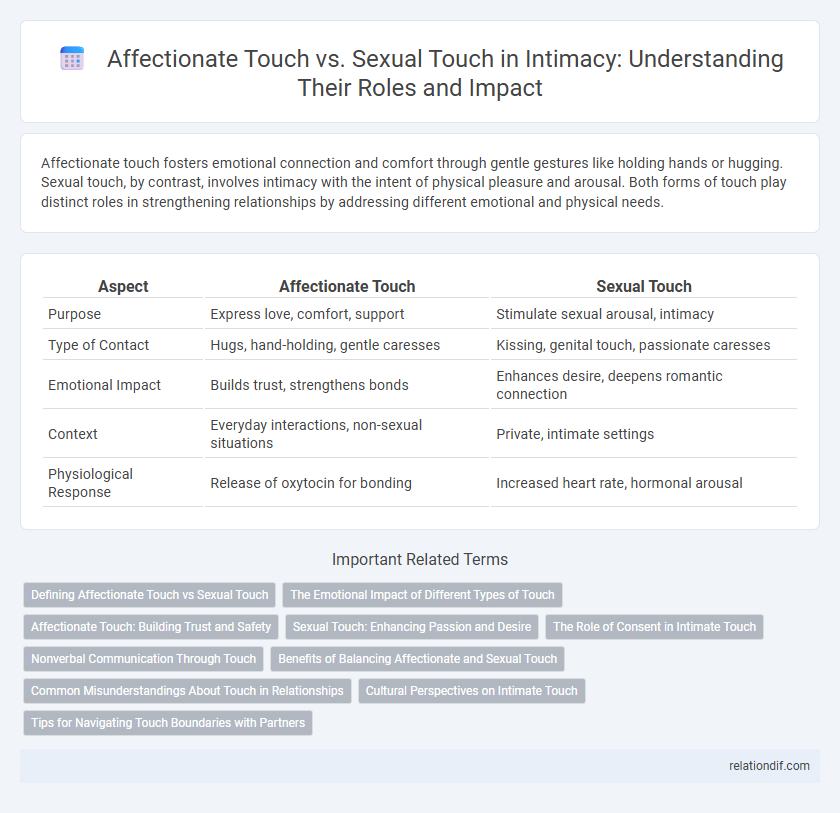Affectionate touch fosters emotional connection and comfort through gentle gestures like holding hands or hugging. Sexual touch, by contrast, involves intimacy with the intent of physical pleasure and arousal. Both forms of touch play distinct roles in strengthening relationships by addressing different emotional and physical needs.
Table of Comparison
| Aspect | Affectionate Touch | Sexual Touch |
|---|---|---|
| Purpose | Express love, comfort, support | Stimulate sexual arousal, intimacy |
| Type of Contact | Hugs, hand-holding, gentle caresses | Kissing, genital touch, passionate caresses |
| Emotional Impact | Builds trust, strengthens bonds | Enhances desire, deepens romantic connection |
| Context | Everyday interactions, non-sexual situations | Private, intimate settings |
| Physiological Response | Release of oxytocin for bonding | Increased heart rate, hormonal arousal |
Defining Affectionate Touch vs Sexual Touch
Affectionate touch involves gentle, non-sexual physical contact such as hugging, holding hands, or a light caress, which fosters emotional connection and trust between partners. Sexual touch specifically aims to elicit arousal and sexual response, often characterized by more intimate and intentional contact with erogenous zones. Understanding the distinction between affectionate and sexual touch helps clarify boundaries and enhances communication in intimate relationships.
The Emotional Impact of Different Types of Touch
Affectionate touch, such as gentle caresses or holding hands, fosters trust, reduces stress, and strengthens emotional bonds by releasing oxytocin, the "love hormone." Sexual touch often triggers intense arousal and connection, enhancing intimacy through dopamine and endorphin release. Both types of touch deeply influence emotional well-being, but affectionate touch primarily nurtures comfort and security, while sexual touch intensifies passion and desire.
Affectionate Touch: Building Trust and Safety
Affectionate touch, such as gentle hand-holding or a warm embrace, plays a crucial role in building trust and safety within intimate relationships by promoting oxytocin release, which fosters emotional bonding. Unlike sexual touch, which is primarily associated with physical desire and arousal, affectionate touch focuses on comfort, reassurance, and emotional connection, helping partners feel secure and valued. Consistent affectionate touch strengthens attachment, reduces stress hormones, and creates a foundation for deeper intimacy and mutual trust.
Sexual Touch: Enhancing Passion and Desire
Sexual touch plays a crucial role in enhancing passion and desire by directly stimulating erogenous zones and triggering an intense release of oxytocin and dopamine, which heighten emotional connection and arousal. Unlike affectionate touch, sexual touch activates the body's physiological responses aligned with intimacy, increasing heart rate and blood flow to sensitive areas. This form of touch fosters deeper bonding and excitement within relationships, amplifying mutual attraction and sustaining long-term desire.
The Role of Consent in Intimate Touch
Consent plays a crucial role in distinguishing affectionate touch from sexual touch, ensuring that both parties feel safe and respected in intimate interactions. Clear, enthusiastic agreement prevents misunderstandings and reinforces boundaries, fostering trust and emotional connection. Prioritizing consent empowers individuals to communicate their comfort levels, promoting healthy and consensual expressions of intimacy.
Nonverbal Communication Through Touch
Nonverbal communication through touch plays a crucial role in distinguishing affectionate touch from sexual touch, as affectionate touch often conveys comfort, support, and bonding without sexual intent. Research shows that affectionate touch, such as holding hands or gentle caresses, activates the brain's release of oxytocin, promoting trust and emotional connection, whereas sexual touch triggers arousal-related neural pathways. Understanding these subtle differences enhances intimacy by fostering emotional closeness through nonverbal cues that prioritize relational bonding over physical desire.
Benefits of Balancing Affectionate and Sexual Touch
Balancing affectionate and sexual touch enhances emotional connection by fostering trust and security, which deepens intimacy between partners. Affectionate touch, such as hugging and gentle caresses, promotes the release of oxytocin, reducing stress and increasing feelings of closeness. Incorporating both types of touch supports relationship satisfaction and overall well-being by meeting physical and emotional needs simultaneously.
Common Misunderstandings About Touch in Relationships
Affectionate touch, such as holding hands or gentle hugging, fosters emotional connection and trust, while sexual touch primarily aims to express desire and intimacy at a physical level. Common misunderstandings in relationships often arise when these types of touch are confused, leading to misinterpretations of intent and emotional needs. Clarifying the difference between affectionate and sexual touch can enhance communication, reduce tension, and deepen intimacy between partners.
Cultural Perspectives on Intimate Touch
Cultural perspectives on intimate touch distinctly differentiate affectionate touch from sexual touch, shaping social norms and personal boundaries. In many collectivist societies, affectionate touch such as holding hands or hugging is reserved for family and close friends, while sexual touch is strictly private and often stigmatized. Contrastingly, some Western cultures embrace a broader acceptance of affectionate touch in public spaces, yet maintain clear distinctions between non-sexual and sexual contact to preserve social decorum and respect.
Tips for Navigating Touch Boundaries with Partners
Establishing clear communication about affectionate touch versus sexual touch is essential for building trust and respecting boundaries within intimate relationships. Partners should prioritize expressing their comfort levels honestly, setting specific consent rules, and recognizing nonverbal cues to navigate physical interactions safely. Regularly revisiting these boundaries ensures mutual understanding and reinforces emotional connection while honoring personal limits.
affectionate touch vs sexual touch Infographic

 relationdif.com
relationdif.com